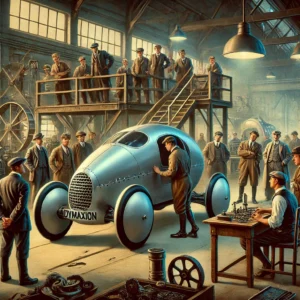 On July 12, 1933, the first Dymaxion car, designed by the visionary inventor Buckminster Fuller, rolled off the production line. This groundbreaking vehicle was a product of Fuller’s inventive spirit and his desire to revolutionize transportation. The Dymaxion car featured a striking teardrop shape and an unconventional three-wheel layout, with two wheels at the front and one at the rear. This design aimed to maximize aerodynamic efficiency, reducing drag and improving fuel economy. The car was intended to achieve high speeds and impressive fuel efficiency, embodying Fuller’s philosophy of doing more with less.
On July 12, 1933, the first Dymaxion car, designed by the visionary inventor Buckminster Fuller, rolled off the production line. This groundbreaking vehicle was a product of Fuller’s inventive spirit and his desire to revolutionize transportation. The Dymaxion car featured a striking teardrop shape and an unconventional three-wheel layout, with two wheels at the front and one at the rear. This design aimed to maximize aerodynamic efficiency, reducing drag and improving fuel economy. The car was intended to achieve high speeds and impressive fuel efficiency, embodying Fuller’s philosophy of doing more with less.
Despite its innovative design, the Dymaxion car faced significant challenges. The vehicle’s unusual appearance and advanced features were far ahead of their time, and it struggled to gain acceptance from the public and investors. Only three prototypes were ever built, and the project was eventually discontinued after a series of unfortunate events, including a fatal accident involving one of the prototypes. Nevertheless, the Dymaxion car left a lasting impact on the world of automotive design. Its principles of aerodynamic efficiency and lightweight construction would later influence the development of more modern vehicles.
The legacy of the Dymaxion car extends beyond its limited production. It remains a symbol of early 20th-century optimism and the belief in the transformative power of technology. Fuller’s visionary ideas, encapsulated in the Dymaxion car, continue to inspire designers and engineers to think creatively and push the boundaries of what is possible. The car’s design serves as a reminder of the importance of innovation and the potential for visionary thinking to shape the future. Even though the Dymaxion car never achieved commercial success, its spirit of ingenuity and forward-thinking design principles endure as a testament to Buckminster Fuller’s extraordinary vision.
